912 scholarly books by University of Massachusetts Press and 6
have author last names that start with Y
912 scholarly books by University of Massachusetts Press and 6
912 scholarly books by University of Massachusetts Press
6 have author last names that start with Y have author last names that start with Y
6 have author last names that start with Y have author last names that start with Y
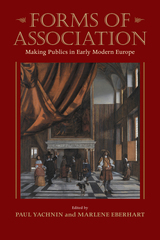
Forms of Association
Making Publics in Early Modern Europe
Paul Yachnin
University of Massachusetts Press, 2015
In today's connected and interactive world, it is hard to imagine a time when cultural and intellectual interests did not lead people to associate with others who shared similar views and preoccupations. In this volume of essays, fifteen scholars explore how these kinds of relationships began to transform early modern European culture.
Forms of Association grows out of the "Making Publics: Media, Markets, and Association in Early Modern Europe" (MaPs) project, funded by the Social Sciences and Humanities Research Council of Canada. This scholarly initiative convened an interdisciplinary research team to consider how "publics"—new forms of association built on the shared interests of individuals—developed in Europe from 1500 to 1700. Drawing on a wide array of texts and histories, including the plays of Shakespeare, the legend of Robin Hood, paintings, and music as well as English gossip about France, the contributors develop a historical account of what publics were in early modern Europe. This collaborative study provides a dynamic way of understanding the political dimensions of artistic and intellectual works and opens the way toward a new history of early modernity.
Until his death in 2008, the great Renaissance scholar Richard Helgerson was a key participant in the MaPs project. The scholars featured in this volume originally met in Montreal to engage in a critical, commemorative conversation about Helgerson's work, the issues and questions coming out of the MaPs project, and how Helgerson's thinking advanced and could in turn be advanced by MaPs. This collection represents the fruits of that conversation.
Forms of Association grows out of the "Making Publics: Media, Markets, and Association in Early Modern Europe" (MaPs) project, funded by the Social Sciences and Humanities Research Council of Canada. This scholarly initiative convened an interdisciplinary research team to consider how "publics"—new forms of association built on the shared interests of individuals—developed in Europe from 1500 to 1700. Drawing on a wide array of texts and histories, including the plays of Shakespeare, the legend of Robin Hood, paintings, and music as well as English gossip about France, the contributors develop a historical account of what publics were in early modern Europe. This collaborative study provides a dynamic way of understanding the political dimensions of artistic and intellectual works and opens the way toward a new history of early modernity.
Until his death in 2008, the great Renaissance scholar Richard Helgerson was a key participant in the MaPs project. The scholars featured in this volume originally met in Montreal to engage in a critical, commemorative conversation about Helgerson's work, the issues and questions coming out of the MaPs project, and how Helgerson's thinking advanced and could in turn be advanced by MaPs. This collection represents the fruits of that conversation.
[more]
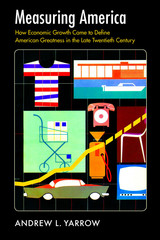
Measuring America
How Economic Growth Came to Define American Greatness in the Late Twentieth Century
Andrew L. Yarrow
University of Massachusetts Press, 2010
The United States has always fancied itself a nation apart—"exceptional" in its values, traditions, and way of life. For most of the country's history, ideas about what made America distinctive generally were framed in terms of a liberal idealism rooted in the thought of John Locke and articulated by Jefferson, Madison, and other Founders. While some commentators also observed that the United States was a land of plenty, it wasn't until the mid-twentieth century that material abundance emerged as the principal standard of American "greatness," as measured by a host of new economic indicators.
Beginning in earnest in the wake of World War II, opinion-shapers in politics, business, academia, the media, the schools, and public diplomacy gloried in the nation's booming economy. Where "plenty" had once been a largely abstract concept, it was now quantifiable, thanks to new national income accounting and other economic data collection and analysis techniques. One could tally up production and consumption of an ever-expanding cornucopia of goods and services that made up the gross national product (GNP), the king of postwar statistics. American preeminence and American identity were increasingly linked with this measurable prosperity, presented in the language of a newly influential economics profession.
In Measuring America, Andrew L. Yarrow explores this history, telling two parallel, interlocking stories—of how economic ideas came to have vastly greater influence on American culture after World War II, and how those ideas dovetailed with a growing belief that the meaning and value of the United States resided in its material output. How and why this new way of "measuring America" developed, how it was expressed, and what it has meant and means for Americans today are the subject of this well-researched and insightful book.
Beginning in earnest in the wake of World War II, opinion-shapers in politics, business, academia, the media, the schools, and public diplomacy gloried in the nation's booming economy. Where "plenty" had once been a largely abstract concept, it was now quantifiable, thanks to new national income accounting and other economic data collection and analysis techniques. One could tally up production and consumption of an ever-expanding cornucopia of goods and services that made up the gross national product (GNP), the king of postwar statistics. American preeminence and American identity were increasingly linked with this measurable prosperity, presented in the language of a newly influential economics profession.
In Measuring America, Andrew L. Yarrow explores this history, telling two parallel, interlocking stories—of how economic ideas came to have vastly greater influence on American culture after World War II, and how those ideas dovetailed with a growing belief that the meaning and value of the United States resided in its material output. How and why this new way of "measuring America" developed, how it was expressed, and what it has meant and means for Americans today are the subject of this well-researched and insightful book.
[more]
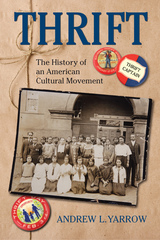
Thrift
The History of an American Cultural Movement
Andrew L. Yarrow
University of Massachusetts Press, 2014
In this lively and engaging book, Andrew L. Yarrow tells the story of a national movement that promoted an amalgam of values and practices ranging from self-control, money management, and efficiency to conservation, generosity, and planning for the future—all under the rubric of “thrift.” Emerging in tandem and in tension with the first flowerings of consumer society, the thrift movement flourished during the 1910s and 1920s and then lingered on the outskirts of American culture from the Depression to the prosperous mid-twentieth century. The movement brought together a diverse array of social actors with widely divergent agendas—the YMCA, the Boy and Girl Scouts, temperance crusaders, and others seeking to strengthen the moral fiber of urban young men and boys in particular, and to damp down the appeal of radicalism. It also attracted credit union and other progressive activists wanting to empower the working class economically, bankers desiring to broaden their customer base, conservationists and efficiency proponents denouncing “waste,” and government leaders, school teachers, and economists who believed that encouraging saving was in the economic interests of both individuals and the nation. A post–World War II culture that centered on spending and pleasure made the early-twentieth-century thrift messages seem outdated. Nonetheless, echoes of thrift can be found in currently popular ideas of “sustainability,” “stewardship,” and “simplicity” and in efforts to curtail public and private debt.
[more]
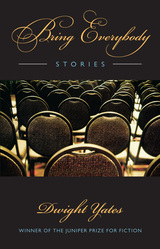
Dwight Alan Yates
University of Massachusetts Press
In this exhilarating collection of stories, Dwight Yates delivers the range of characters suggested in the title, many of them struggling to salvage situations they feel have been thrust upon them. Yet the smoking gun that accounts for the hole in the foot, is, more often than not, in the hand of the protagonist complaining of the pain.
Self-delusion courts self-destruction in these stories, but not without relief, since revelation is always possible and redemption just might come tumbling after. Though the stakes are sometimes low and the circumstances more rueful than tragic, Yates illuminates the gulf between expectation and reality with humor and compassion.
Seduction does not inevitably lead to abandonment in these tales, although that is certainly one outcome. A disastrous young marriage is another. In one case, a seducer comes to see that a chance encounter with an old flame has not closed an incomplete narrative from the past, but most likely has opened a perilous new chapter.
Other stories investigate dormant dread awakened by the hiccup of circumstance. A family man's decision to stop and assist a stalled motorist does not imperil his family as his wife fears. Yet the encounter reveals a burden of faith and guilt that continues to haunt this Samaritan and prompts his irrational, yet perhaps admirable, behavior. In another family tale, a father struggles with the imminent independence of his daughter, a struggle that, like much in his life, is distorted by his curious infatuation with the insomnia afflicting him. The collection's final piece concerns an aging, retired accountant who, stricken with intimations of mortality, hastily attempts to become well loved and eventually handsomely eulogized by undertaking good works, an undertaking he persists in pursuing against mounting odds.
Men and women tell many of their own stories here. In other outings, the telling rests with bemused and attentive narrators, crowding in close, better to witness the charm and folly of the memorable characters assembled in this prize-winning collection.
Self-delusion courts self-destruction in these stories, but not without relief, since revelation is always possible and redemption just might come tumbling after. Though the stakes are sometimes low and the circumstances more rueful than tragic, Yates illuminates the gulf between expectation and reality with humor and compassion.
Seduction does not inevitably lead to abandonment in these tales, although that is certainly one outcome. A disastrous young marriage is another. In one case, a seducer comes to see that a chance encounter with an old flame has not closed an incomplete narrative from the past, but most likely has opened a perilous new chapter.
Other stories investigate dormant dread awakened by the hiccup of circumstance. A family man's decision to stop and assist a stalled motorist does not imperil his family as his wife fears. Yet the encounter reveals a burden of faith and guilt that continues to haunt this Samaritan and prompts his irrational, yet perhaps admirable, behavior. In another family tale, a father struggles with the imminent independence of his daughter, a struggle that, like much in his life, is distorted by his curious infatuation with the insomnia afflicting him. The collection's final piece concerns an aging, retired accountant who, stricken with intimations of mortality, hastily attempts to become well loved and eventually handsomely eulogized by undertaking good works, an undertaking he persists in pursuing against mounting odds.
Men and women tell many of their own stories here. In other outings, the telling rests with bemused and attentive narrators, crowding in close, better to witness the charm and folly of the memorable characters assembled in this prize-winning collection.
[more]
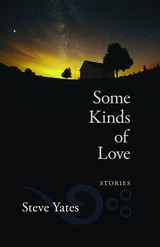
Some Kinds of Love
Stories
Steve Yates
University of Massachusetts Press, 2013
Sometimes the opposite of love is not hate, but depravity. In these twelve stories set in the Missouri Ozarks, New Orleans, and Mississippi, Steve Yates reveals lovers clawing back from precipices of destructiveness, obsessiveness, cruelty, vanity, or greed. They seek escape and yet find new barriers, realizing true love may not be at all what they imagined. Pioneers, limestone quarry owners, young German American Civil War survivors, bankers, sex toy catalog designers, highway engineers, Pakistani terrorists, attorneys, missile guidance masterminds, and furniture factory workers (who can see the future) populate these pieces. From the Ozarks of the 1830s, when locals perceive doomsday in a historic starfall, to the near future at an all-night slow-pitch softball tournament when Armageddon looms yet again, these stories chart the dark side of love, the ties that bind families, and the sweet complications of human desire.
[more]

The Stages of Memory
Reflections on Memorial Art, Loss, and the Spaces Between
James E. Young
University of Massachusetts Press, 2018
Winner of the 2017 National Council on Public History Book Award
From around the world, whether for New York City's 9/11 Memorial, at exhibits devoted to the arts of Holocaust memory, or throughout Norway's memorial process for the murders at Utøya, James E. Young has been called on to help guide the grief stricken and survivors in how to mark their losses. This poignant, beautifully written collection of essays offers personal and professional considerations of what Young calls the "stages of memory," acts of commemoration that include spontaneous memorials of flowers and candles as well as permanent structures integrated into sites of tragedy. As he traces an arc of memorial forms that spans continents and decades, Young returns to the questions that preoccupy survivors, architects, artists, and writers: How to articulate a void without filling it in? How to formalize irreparable loss without seeming to repair it?
Richly illustrated, the volume is essential reading for those engaged in the processes of public memory and commemoration and for readers concerned about how we remember terrible losses.
From around the world, whether for New York City's 9/11 Memorial, at exhibits devoted to the arts of Holocaust memory, or throughout Norway's memorial process for the murders at Utøya, James E. Young has been called on to help guide the grief stricken and survivors in how to mark their losses. This poignant, beautifully written collection of essays offers personal and professional considerations of what Young calls the "stages of memory," acts of commemoration that include spontaneous memorials of flowers and candles as well as permanent structures integrated into sites of tragedy. As he traces an arc of memorial forms that spans continents and decades, Young returns to the questions that preoccupy survivors, architects, artists, and writers: How to articulate a void without filling it in? How to formalize irreparable loss without seeming to repair it?
Richly illustrated, the volume is essential reading for those engaged in the processes of public memory and commemoration and for readers concerned about how we remember terrible losses.
[more]
READERS
Browse our collection.
PUBLISHERS
See BiblioVault's publisher services.
STUDENT SERVICES
Files for college accessibility offices.
UChicago Accessibility Resources
home | accessibility | search | about | contact us
BiblioVault ® 2001 - 2024
The University of Chicago Press









